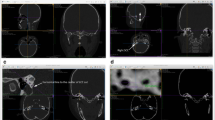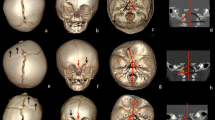Abstract
Background
Standardized cephalometric measurements are necessary to compare skulls of different ages and sizes, in normal and diseased subjects, and in different species. In diseases involving the skull base, classical cephalometry is often impossible because the cranial landmarks are modified. In vestibular orientation (VO), the plane of the lateral semicircular canal (LSCC) of the inner ear, which has a constant relation to gravity, defines the horizontal plane of reference. Defining a reference plane independent of external landmarks is especially important in unicoronal craniosynostosis (UCCS), because the skull base is asymmetrical.
Aim of the study
To illustrate the interest of VO in clinical practice, we report on our experience with VO-based correction of UCCS.
Materials and methods
Since 1992, we have used VO-3D computed tomography scanner for surgical planning of all patients with UCCS, measuring the required correction as the discrepancy between the theoretical and the observed midline.
Results
Thirty-eight children were operated under the age of 2 years for UCCS and evaluated after a mean follow-up of 66 months. Thirty-two (84%) were considered perfect, four (11%) had mild imperfection not requiring reoperation, and two (5%) required reoperation because of progressive craniosynostosis involving the sagittal suture. Good surgical results were obtained when the orbits were correctly oriented relative to the plane of the LSCC.
Conclusions
VO is a useful reference system for the evaluation and surgical planning of UCCS. We hypothesize that the mismatch between the visual and labyrinthic sensorial inputs plays a role in the pathophysiology of UCCS.












Similar content being viewed by others
References
Bécart JM, Donazzan M, Piral T (1997) Volume facial et sa position globale en orientation vestibulaire, chez l’adulte et durant la croissance [Facial volume and its global position in vestibular orientation, in adults and during growth]. Rev Stomatol Chir Maxillofac 98(Suppl 1):79–84
Besson A, Pellerin P, Doual A (2002) Study of asymmetries of the cranial vault in plagiocephaly. J Craniofac Surg 13:664–669
Di Rocco C, Velardi F (1988) Nosographic identification and classification of plagiocephaly. Child’s Nerv Syst 4:9–15
Fénart R (1996) Répartition spatiale des volumes faciaux. Etude ontogénique et phylogénique en orientation vestibulaire [Spatial distribution of facial volumes. Ontogenetic and phylogenetic study with vestibular orientation]. Bull Assoc Anat 80:13–16
Genitori L, Zanon N, Denis D, Erdincler P, Achouri M, Lena G, Choux M (1994) The skull base in plagiocephaly. Child’s Nerv Syst 10:217–223
Gosain AK, Steele MA, McCarthy JG, Thorne CH (1996) A prospective study of the relationship between strabismus and head posture in patients with frontal plagiocephaly. Plast Reconstr Surg 97:881–891
Hilling DE, Mathijssen I, Mulder PGH, Vaandrager JM (2006) Long-term aesthetic results of fronto-orbital correction for frontal plagiocephaly. J Neurosurg (Pediatrics) 105(Suppl 1):21–25
Kreiborg S (2000) Postnatal growth and development of the craniofacial complex in premature synostosis. In: Cohen MM, MacLean RE (eds) Craniosynostosis: diagnosis, evaluation, and management, 2nd edn. Oxford University Press, Oxford, pp 158–174
Marsh JL, Gado MH, Vannier M, Stevens WG (1986) Osseous anatomy of unilateral coronal synostosis. Cleft Palate J 23:87–100
Pellerin P, Piral T, Pertuzon B, Dhellemmes P, Fenart R (1994) Vestibular orientation of the skull by means of the CT-scan in cranio facial deformities. In: Ortiz-Monasterio F (ed) Craniofacial surgery, vol. 5. Monduzzi, Bologna, pp 3–7
Pellerin P, Fénart R, Piral T, Dhellemmes P, Ferri J (1995) Les applications chirurgicales des orientations vestibulaires. [The surgical application of vestibular orientation]. Rev Stomatol Chir Maxillofac 96:214
Pertuzon B, Pruvo JP, Pellerin P, Ferri J, Piral T, Fenart R (1995) Technique de l’orientation vestibulaire par imagerie numérisée [A method of vestibular orientation using digital imaging]. Rev Stomatol Chir Maxillofac 96:209–213
Piral T, Pertuzon B, Empereur-Buisson R, Pellerin P, Donazzan M, Fenart R (1995) Orientation vestibulaire en pathologie cranio-maxillo-faciale [The surgical application of vestibular orientation]. Rev Stomatol Chir Maxillofac 96:207–209
Reddy K, Hoffmann H, Armstrong D (1990) Delayed and progressive multiple suture craniosynostosis. Neurosurgery 26:442–448
Renier D, Arnaud E, Marchac D (2006) Craniosténoses: résultats fonctionnels et morphologiques post-opératoires [Craniosynostosis: functional and morphologic postoperative results]. Neurochirurgie 53:302–310
Author information
Authors and Affiliations
Corresponding author
Rights and permissions
About this article
Cite this article
Vinchon, M., Pellerin, P., Pertuzon, B. et al. Vestibular orientation for craniofacial surgery: application to the management of unicoronal synostosis. Childs Nerv Syst 23, 1403–1409 (2007). https://doi.org/10.1007/s00381-007-0471-x
Received:
Published:
Issue Date:
DOI: https://doi.org/10.1007/s00381-007-0471-x




